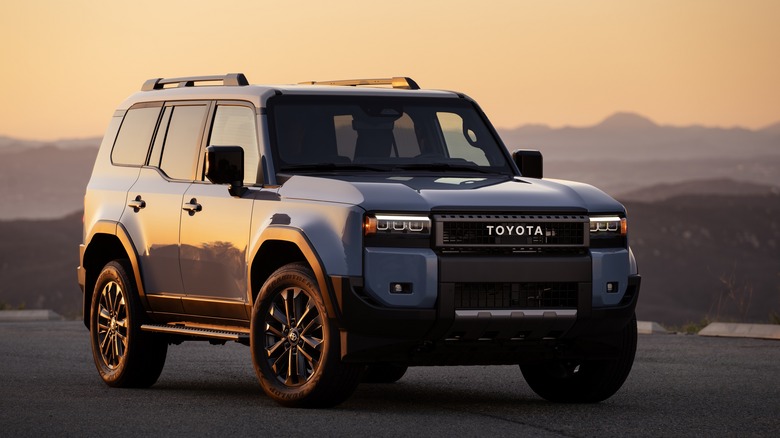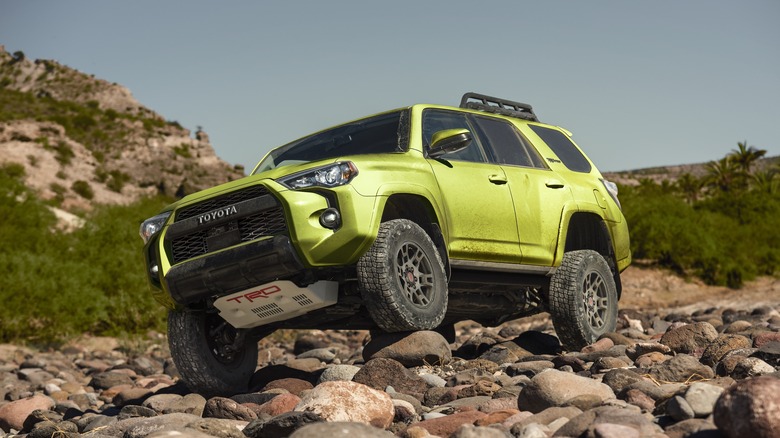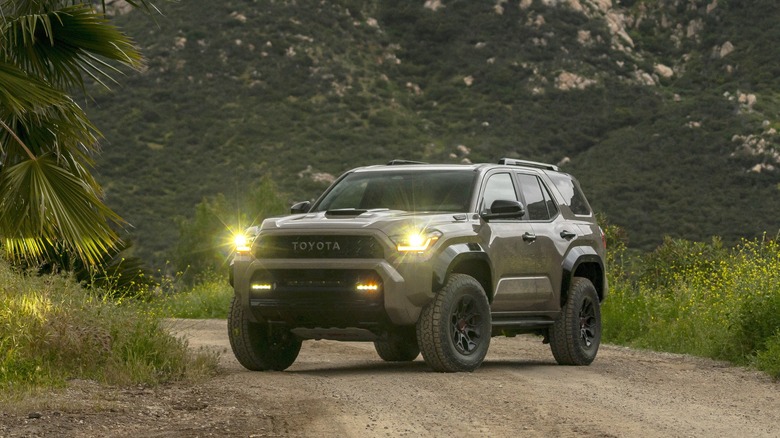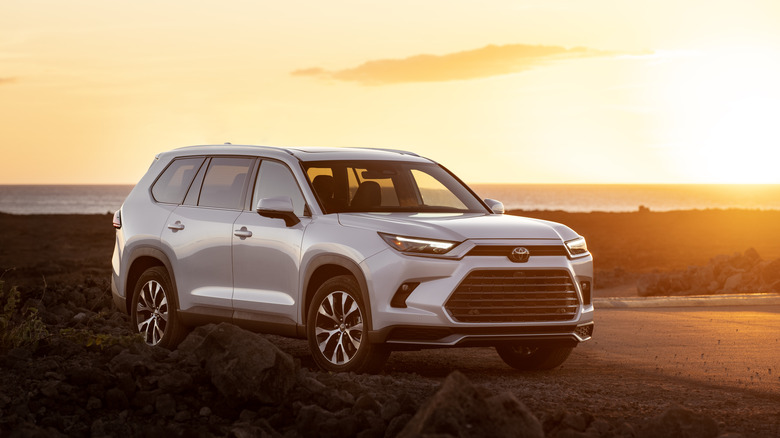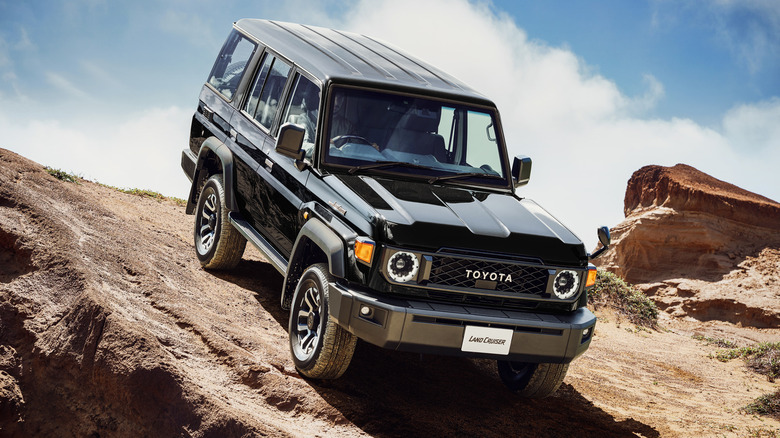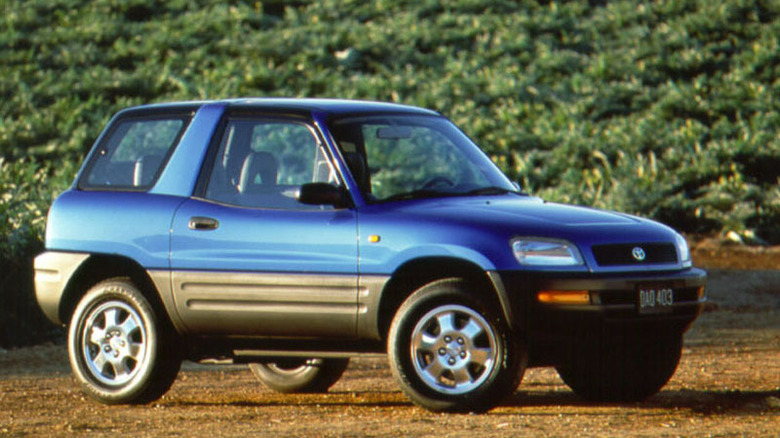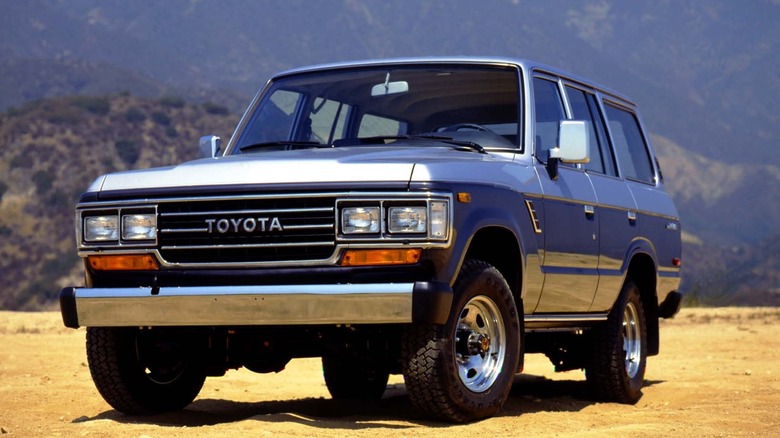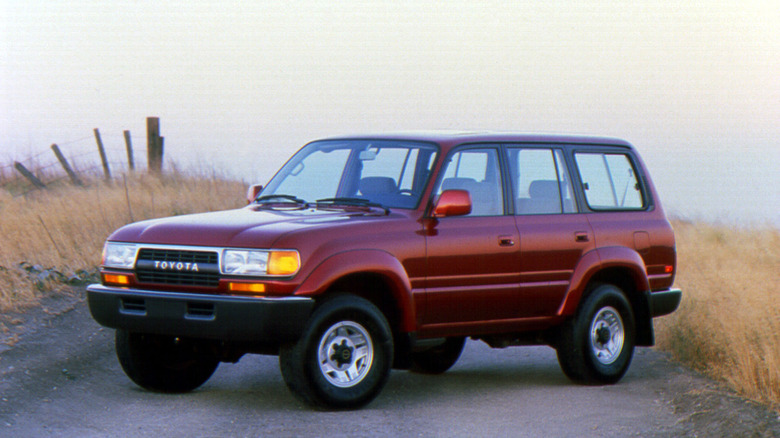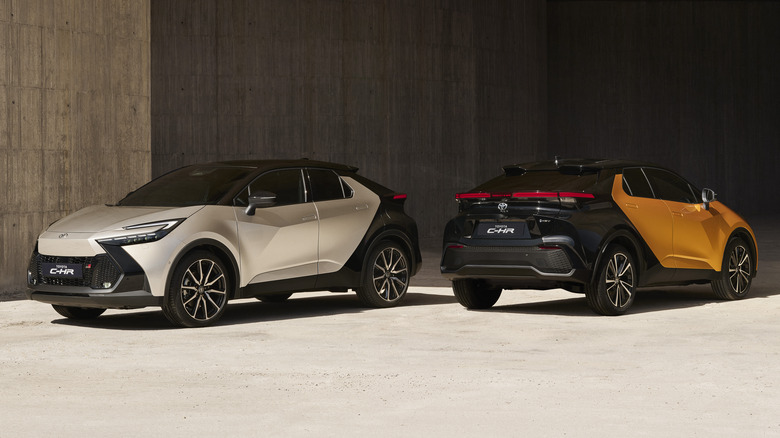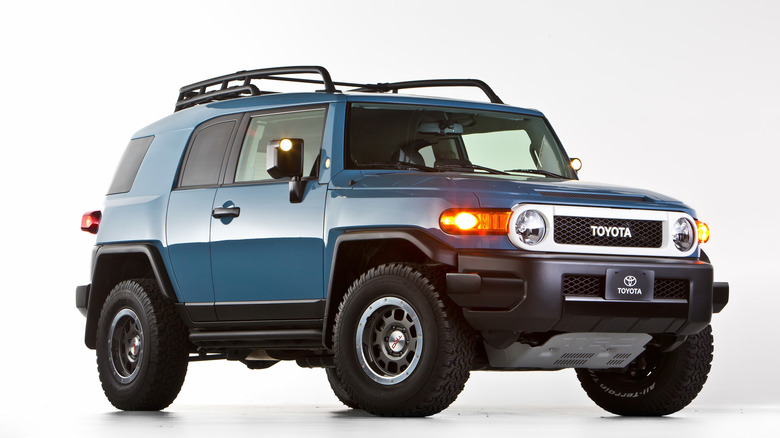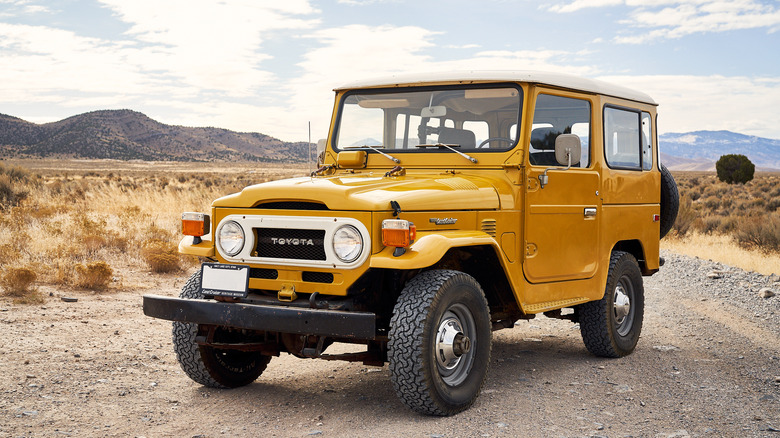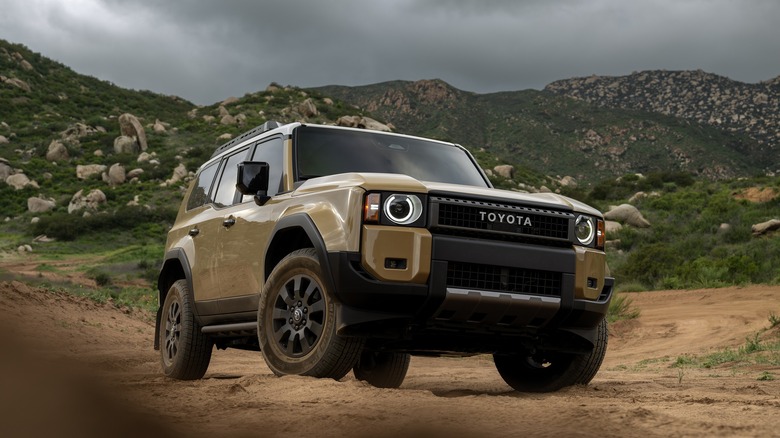11 Of The Best Looking Toyota SUVs Ever Designed
Although it's the world's largest automaker, Toyota is not a company you'd often hear being mentioned in discussions about automotive design. The company has never really had a signature design feature, something to differentiate it from other manufacturers. Sure, it introduces new design languages and styling features, but they tend to change after a generation or two. Its car designs just don't have much staying power.
However, that's not to say Toyota produces unattractive vehicles. It only recently escaped its "conservative" moniker, but the automaker's design departments have regularly produced vehicles people find appealing all over the world. Toyota has eight design studios worldwide — lately it's been putting out some offerings that look quite eye-catching, and that's particularly true of its SUVs.
Toyota has a long history of handsome SUVs. Land Cruisers from half a century ago are still hugely popular as classic vehicles and restomods, but what about the rest? What are the best-looking Toyota SUVs ever? After painstakingly examining every SUV Toyota has ever produced, here is our impartial but completely subjective take on the matter, including SUVs and crossover SUVs. Enjoy!
Toyota 4Runner fifth-gen facelift (2013 to 2024)
Launched 15 years ago, the fifth-gen Toyota 4Runner has mechanical bits that seem out of place in 2024. Its 270 hp 4.0-liter V6 is underpowered by today's standards, and the five-speed automatic transmission has three fewer gears than the current norm. But people love the fifth-gen 4Runner precisely because it's a back-to-basics SUV that won't struggle when things get rough. Thanks to its tough body-on-frame platform and reliable internals, it's still one of the best off-road SUVs, even compared to the recently launched sixth-gen model.
It looks the part, too, particularly the facelifted model launched in 2013. We won't argue that it could win a design contest, but the fifth-gen 4Runner facelift radiates robustness as few other SUVs do. The best bit is the front fascia, which manages to look tough and purposeful without resorting to a humongous grille like most other trucks/SUVs do nowadays. The grille is big, yes, but it doesn't look out of place. Moreover, the headlights are positioned very high, giving the 4Runner an authoritative presence.
The side profile is muscular, too, with bulged fenders and classic, boxy SUV proportions. The rear end is slightly less interesting, but Toyota's designers still played with the panel surfaces to give the fifth-gen 4Runner a bolder look. Add larger all-terrain tires and a roof rack, like on the TRD Pro model, and Toyota's off-road SUV becomes even more noticeable, if not attention-grabbing.
Toyota 4Runner N380 (2024)
While the fifth-gen 4Runner was behind the times in certain aspects, the brand-new sixth-gen model is the polar opposite. Gone are the antiquated engine and transmission, replaced by a 2.4-liter inline-four turbo and an eight-speed automatic. Toyota even offers an i-Force Max hybrid version with a total power output of 326 hp and a massive 465 lb-ft of torque, making it by far the most powerful and most torquey 4Runner ever.
While 2025 4Runner's advanced tech-laden platform might not convince aficionados to upgrade, there is no denying the new SUV's off-road credentials. You can get the 2025 4Runner with a full-time 4WD, two-speed transfer case, high/low range, Active Traction Control (A-TRAC), and automatic limited slip differential (Auto LSD), so going deep into the wilderness shouldn't be an issue.
Rough environments suit the 2025 4Runner, too. It has a much more aggressive design than its predecessor, with a wide, muscular stance intensified by bulging fenders and short overhangs. The front end is even flashier and quite striking, largely due to the huge grille borrowed from the Tacoma. Even so, Toyota designers were smart to cut the grille in half, giving it a stepped look that works quite well here. The rear end is a bit more sedate but still looks rugged enough, especially in the TRD Pro and Trailhunter models. Toyota's greatest achievement, though, is that it managed to keep the 4Runner spirit alive. The 2025 model looks more audacious, but is still unmistakably a 4Runner.
Toyota Grand Highlander (2023 to Present)
The regular Highlander has been quite popular among families, but it was never attractive to look at. That all changed with the larger Grand Highlander, which is one of the sleekest crossover SUVs currently on sale. There is nothing brash about the styling of the Grand Highlander, and that's a smart move. Toyota's three-row family vehicle sits higher from the ground, but you won't mistake it for an off-road vehicle because it looks nothing like the 4Runner and Land Cruiser.
The Grand Highlander doesn't look as sturdy, but it's still an attractive SUV. The understated design works in its favor here, as it hides its size well (around 17 feet long) while accentuating the sporty appearance. Toyota did a particularly good job with the body creases and surfaces, which provide vigor to the otherwise classic crossover shape. The front end, although featuring a fairly large, divided grille, has a keen, dynamic design that adds a dash of sportiness to the picture. Meanwhile, the C-shaped taillights energize the rear end, aided by the proudly presented Grand Highlander logotype in between.
Still, the Grand Highlander isn't only about looking cool — it's also about making you comfortable. In our review, we found that it offers space for adult passengers in all three rows and a usable trunk. It rides smoothly, too, though attacking corners vigorously won't bring a smile to your face. Not that this should matter in a family hauler, but the optional 362-hp Hybrid Max powertrain suggests more spirited driving.
Toyota Land Cruiser 70 Series (2023 to Present)
Retro is the new cool in automotive design. The latest Bronco borrows design elements from the first-gen model; the Wrangler still looks like it did decades ago, and overseas, the Suzuki Jimny wins over customers with its vintage looks. But the SUV that wears retro the best is the 70-Series Land Cruiser because it is vintage. Toyota refreshed the hugely popular SUV last year, but make no mistake, the 70-Series sits on the same platform launched in 1984.
So, not only does this SUV look old-fashioned, but it also gives you a history lesson once you start driving it. That's particularly true for the V8 turbodiesel, which has recently been discontinued, but the new four-cylinder turbodiesel should be agricultural enough. Crucially, the durable and reliable ladder frame remains present, giving the 70-Series Land Cruiser longevity that's hard to match in most modern SUVs.
You'll also be hard-pressed to find a modern SUV alternative with a similar design. Toyota's designers enhanced the looks with a more sculpted bonnet and new circular LED lights, but the boxy body is the same as the Land Cruiser 70 Series launched four decades ago. There is a simplicity to the styling, all in the name of functionality. Even so, the indents in the side profile add some necessary potency to the J70 and make it quite recognizable. Overall, there is something likable about an off-roader that looks so pure, especially considering all the brash-looking modern SUVs.
Toyota RAV4 3-Door & 2-Door (1994 to 2000)
Tired of all the dull-looking compact crossover SUVs that flood our streets today? You can blame the first-gen RAV4 for that, because it was the first-ever compact crossover SUV. The 1994 RAV4 wasn't conceived as a boring family hauler, but as a car for the modern adventurer. Initially, it was only available as a 3-door hatchback, with a fresh, funky design and a rear-mounted spare urging you to go off-road. Toyota even offered it exclusively with permanent all-wheel-drive — that's how serious it was about the car's all-terrain credentials.
With a 2.0-liter 129-hp engine, the first-gen RAV4 wasn't particularly exciting in a straight line, but its foolish personality makes it the best RAV4 generation in the model's history. Sure, each subsequent RAV4 is more usable, with more space inside, and that includes the 5-door version of the model. However, none has the original's lifestyle character. With its curvaceous yet svelte body, slightly raised rear half, and carefully placed indents in the doors, the three-door RAV4 manages to look both off-roady and car-like at the same time. The fact that it's much shorter than a modern-day Yaris adds to its undeniable attractiveness.
And the hatchback wasn't even the best-looking version — that title belongs to the funky 2-door convertible. With its rear fabric roof, the 2-door RAV4 radiates a happy energy that you won't find in any vehicle today. Its toyish looks are a testament to an era when automakers still designed fun cars, not just functional ones.
Toyota Land Cruiser FJ60/FJ62 (1981 to 1992)
Want to know where the latest Land Cruiser 250 takes its design inspiration from? It's the FJ60 series, which, like the current model, was available with two distinct front ends. Before the facelift, it had circular headlights, like the current 1958 Land Cruiser trim, while after the FJ62 facelift, Toyota opted for square headlights, like on other trims. The FJ60/FJ62 Land Cruisers also have a boxy body and vertical taillights.
However, while the similarities are uncanny, some of the small details on the body are unique for the older model, like the sideline that connects the taillights to the rear fender and front/rear air vents. The proportions are different, too, with the FJ60/FJ62 having a very short front overhang and a long rear one, looking almost like a wagon. No wonder because the FJ60 is the second model in the station wagon series, designed to be more road-focused than the heavy-duty Land Cruisers.
Don't mistake it for a crossover, though. Thanks to its durable boxed ladder frame chassis, solid axle leaf springs, and four-wheel drive with low-range gearbox, the FJ60/FJ62 was a workhorse capable of going deep into the wilderness. Despite its rugged heart, the FJ60/FJ62 was far more luxurious than any Land Cruiser before it, with a roomy, plush interior. Its 4.2-liter inline-six was more powerful than ever, too, though with only 135 hp and 210 lb-ft torque, it still wasn't particularly quick.
Toyota Land Cruiser FJ80 (1990 to 1997)
The FJ80 changed the landscape for the Land Cruiser family, offering a much more of a luxurious touch and less of the ruggedness of previous models. Instead of the boxy, sharp design, Toyota opted for a more rounded appearance. Every line was smoothed out, giving the FJ80 a more polished, refined appearance compared to SUVs of the era.
Even to this day, the FJ80 looks fresh, though its off-road heritage is present in the wide, accentuated fenders, which give the SUV a more muscular look. The front end seems a bit understated compared to modern off-roaders, but the small grille gives off an elegance and sophistication that's unavailable in today's SUVs.
The FJ80 matched its more sophisticated appearance with big internal improvements as well. This was the first Land Cruiser to ditch the leaf springs for coil alternatives, which dramatically improved the ride and road dynamics. However, Toyota was careful to retain the Land Cruiser's off-road prowess. Thus, every FJ80 came with a full-time 4WD with a low-range transfer case and a locking center differential. The powertrain options got better, too. A brand-new 4.1-liter inline-six turbodiesel producing 163 hp was available from the get-go, while a 24-valve, 4.5-liter inline-six gas engine producing 212 hp was introduced in 1992. Meanwhile, the interior got roomier and more luxurious.
Unsurprisingly, it's one of the best Land Cruiser generations ever made.
Toyota C-HR (2023 to Present)
The first-gen C-HR never took off in America, but in Europe, it's one of Toyota's most popular models. And the successor, which was launched last year, looks even more striking than the original. Perhaps striking is not a strong enough word to describe this crossover SUV — it looks like a concept stolen from a car show. The second-gen C-HR is Toyota at its bravest, and easily one of the brand's coolest cars you can't get in the U.S.
Unlike most SUVs on this list, the C-HR doesn't do retro. Instead, it goes a few decades into the future with body creases and surfaces unseen in any other vehicle. Its front end is styled to the teeth, too, with aggressive C-shaped headlights and a huge grille at the bottom. Still, the coupe-like rear end with an LED light bar placed pretty high and a spoiler that's divided in the middle looks even more impressive.
The C-HR is a hybrid-only affair, which suits its sci-fi styling, available with 1.8-liter and 2.0-liter hybrids and a 2.0-liter plug-in hybrid. The PHEV is the most interesting of the lineup, as it produces 223 hp, enough for a solid 0-62 mph acceleration time of 7.4 seconds while providing a 41-mile electric-only range.
Toyota FJ Cruiser (2006 to 2018)
The FJ Cruiser might not be to everyone's taste, but its quirkiness made it a collectible cult classic. Of course, the fact that it was launched to honor the first Land Cruiser FJ40 helps it a bit here, but you can't deny its distinctiveness. However, its most coveted feature is that it was designed to be an off-roader first. Sitting on a short-wheelbase ladder-frame chassis, the FJ Cruiser isn't your typical family hauler — instead, it was designed to put a smile on your face while you tackle challenging terrains.
Visually, we have to admit Toyota's designers captured FJ Cruiser's spirit perfectly. There is quite a lot going on, with retro and modern elements blended together on the outside, but it somehow weirdly works. The vertical windscreen with thin A-pillars, circular headlights positioned closely together, huge C-pillars, asymmetrical doors, and chunky rear end with a full-size spare tacked onto it all give it an unapologetically whimsical vibe.
This design approach created some big blind spots, and the small rear doors are ineffective in tight areas, but functionality clearly played second fiddle to style here. Toyota still made the right choices where it counted and made the FJ Cruiser available with 4WD, a low-range transfer case, an electronic-locking rear differential, and even a 6-speed manual to pair it with the 4.0-liter V6 engine. Let's just hope that the rumored 2025 FJ Cruiser is as interesting as the old one!
Toyota Land Cruiser FJ40 (1960 to 1984)
Although the FJ Cruiser is an attractive retro-looking SUV, we think the FJ40 Land Cruiser wore the same design better. Launched in 1960 to combat Jeep and Land Rover's offerings, the FJ40 quickly captured the hearts of drivers worldwide. It was even the best-selling Toyota in the U.S. from 1961 to 1965 and still enjoys popularity today, with quite a few companies offering restomod FJ40 configurations.
The main reason behind FJ40's success is its legendary reliability. This is a tough vehicle with durable Type F engines and a rugged ladder frame that is unlikely to leave you stranded. It's a capable off-roader, too, courtesy of its short wheelbase, large approach/departure angles, 4WD drivetrain, and low-range/high-range transfer case. Besides, it's a back-to-basics vehicle with no technology onboard, which is a breath of fresh air in today's world. Models produced until 1974 even had a three-speed manual gearbox, later replaced by a four-speed manual — that's how rudimentary it was.
The design has a utilitarian edge to it, like most off-roaders of the era, but Toyota's designers gave it a unique front end with a signature light-colored grille frame. The sculpted bonnet had another air inlet that was an extension of the grille below, and in some models, the roof was painted in the same color as the grille. These details give the FJ40 a more playful vibe and work quite well with the otherwise utilitarian body.
Toyota Land Cruiser 250 (2023 to Present)
The Land Cruiser has retained its rugged image well into the 21st century, but it has a cool edge, especially compared to newcomers like the Ford Bronco and new Land Rover Defender. In 2023, Toyota launched its best-looking Land Cruiser to date — the 250-series. A successor to the light-duty 150 Prado, which also served as a basis for the Lexus GX, the latest Land Cruiser again wows customers with style — not just a reputation for reliability.
The boxy design is a breath of fresh air for the nameplate. Gone are the incoherent looks of its predecessor, and in their place, a truly consistent design from every angle. The Land Cruiser 250 looks quite chunky and muscular, with wide fenders further accentuated by the elevated hood and rear window line, which give it a very powerful stance. The line that goes from the headlights to the taillights further exemplifies the off-road credentials, with the upright windshield taking us back to Land Cruisers of yore.
The fascia is the most prominent feature of the 250, though. Toyota borrowed the design from the FJ60 Land Cruiser and made the new model available with rectangular and circular headlights, depending on the trim. It's a brave move and a talking point among Land Cruiser aficionados. Toyota was also daring enough to electrify the Land Cruiser 250 in America, where it's available with a potent 2.4-liter turbo hybrid producing 326 hp and 465 lb-ft of torque. Despite the move to a modern drivetrain, the 250 didn't lose its effortless off-road talents.
